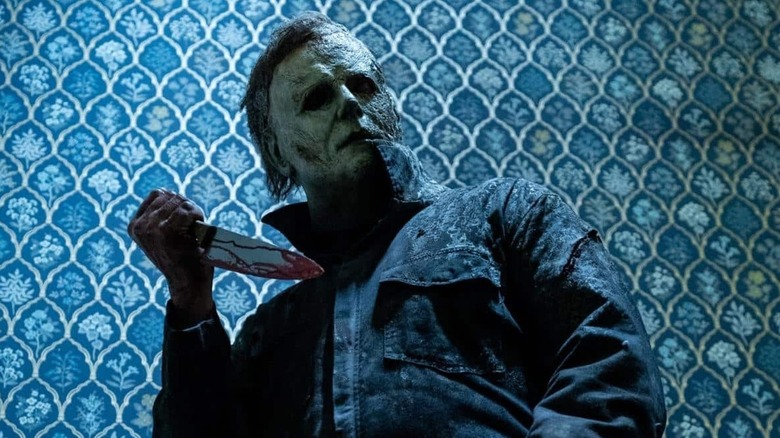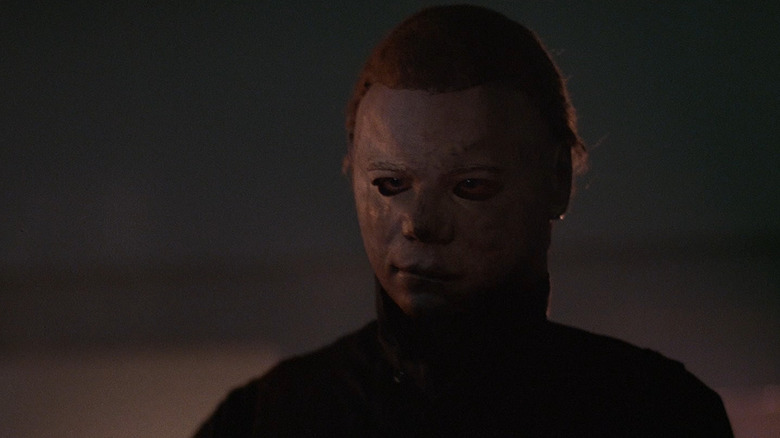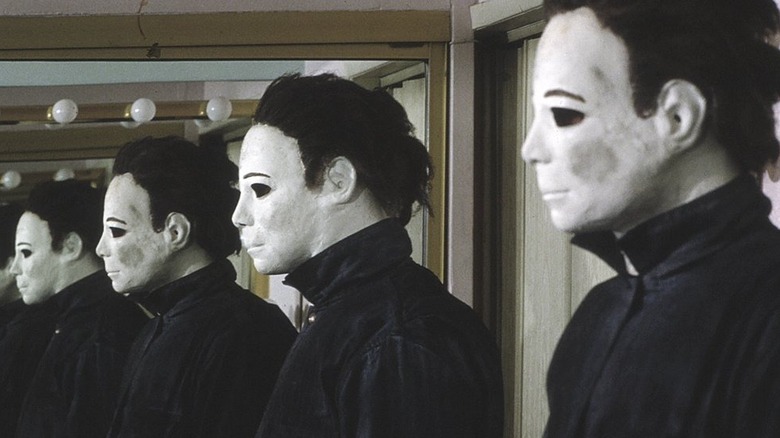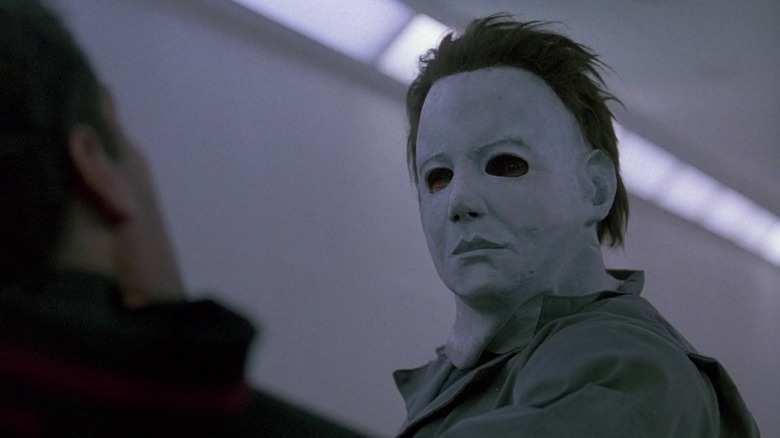David Gordon Green's Halloween Trilogy Pays Homage To The Entire Franchise
To begin with something benign: David Gordon Green's "Halloween Ends," now in theaters and streaming on Peacock, employed an unusual font for its opening titles. As has been discussed in the pages of /Film recently, both John Carpenter's 1978 original and Green's 2018 sequel employed an orange ITC Serif Gothic Heavy font. Both Rick Rosenthal's 1981 sequel "Halloween II," and Green's follow-up "Halloween Kills" uses the same orange on a Standard CT Ext ExtraBold font. Finally, both Tommy Lee Wallace's 1982 film "Halloween III: Season of the Witch" and Green's "Halloween Ends" feature a more simplified font that looks like Helvetica.
Why is this important? Green clearly had an eye on the entire rocky history of the "Halloween" film series, now on its thirteenth entry. While Green's films follow a particular continuity that ignores all the other films in the franchise with the exception of the first, in very subtle ways, they also cleverly acknowledge the ignored films. The series to date has had a few notable highs and a few very low lows, but fans of the "Halloween" movies have varying levels of appreciation for them all, and they will happily re-watch any one of the crummier entries just to throw out a few choice, good-natured jibes. Green and his co-screenwriters Danny McBride, Chris Bernier, and Paul Brad Logan, have clearly done a great deal of study, and perhaps jibing, as their trio of "Halloween" movies each takes their structural cues from across the whole franchise.
Halloween (1978) and Halloween II (1981)
One might compare Green's "Halloween" to a cover song. He plays the same tune as the 1978 original, attempting to recreate the mood and sound as accurately as he could and retaining much of the original's same instrumentation. Both the '78 film and the '18 film follow Laurie Strode (Jamie Lee Curtis) living at home when Michael Myers, aka The Shape (Nick Castle in '78, and mostly James Jude Courtney in '18), escapes from a nearby mental institution, puts on a white mask, and treks into Haddonfield, IL on Halloween night in order to wander into people's homes and stab them to death. Laurie was merely babysitting 40 years ago, but in the new film canon, she became a survivalist who has filled her home with weapons and trapdoors specifically built to kill Michael. In both films, a shrink is on Michael's tail, Donald Pleasance in 1978 and Haluk Bilginer in 2018, although they have differing agendas. Overall, the two films are pretty similar in plot and tone.
It appears that Green deliberately ignored the continuity of Rosenthal's "Halloween II" specifically to ignore the conceit that Laurie (Jamie Lee Curtis) is actually Michael Myers' sister. Although just one of many teenagers targeted by Michael in Carpenter's original, Laurie's significance was artificially inflated by familial shenanigans for the sequel. Call it "The Empire Strikes Back" syndrome. "Halloween Kills" (2021) dispenses with that particular twist, but does follow Rosenthal's conceit of taking place on the exact same Halloween night as the prior film. Additionally, Laurie spends both the bulk of "Halloween II" and "Halloween Kills" in a hospital bed, recovering from injuries incurred in the previous film.
Also of note: Rob Zombie's 2009 film, frustratingly also called "Halloween II," spends its first act in a hospital with that film's Laurie (Scout Taylor-Compton) fleeing Michael. This makes "Halloween Kills" a double homage.
Halloween 4 and Halloween 6
The plot of "Halloween Kills" also heavily involves the citizens of Haddonfield, IL forming numerous vengeful posses and fanning out into the town to locate Michael and kill him once and for all. Evil, it seems, dies tonight. This was also a plot element from Dwight H. Little's 1988 sequel "Halloween 4: The Return of Michael Myers." Little's film came after the disappointing "Halloween III: Season of the Witch," which was deliberately not about Michael Myers. For "Halloween 4," the infamous killer was revealed to have been in a coma for years, only to awaken and go on a killing spree, searching specifically for his niece (Danielle Harris), with Laurie having died at some point between movies.
By this point in the original continuity, Michael was a notorious local anti-celebrity, and the citizens were all wounded by the effect of his lingering crimes. That notion drives "Halloween Kills." The citizens have finally become sick and tired of hosting a masked serial killer, and resort to vigilante justice.
One might not expect any references to Joe Chapelle's widely pilloried 1995 film "Halloween: The Curse of Michael Myers," but Green's "Halloween Ends" kind of does that. The conceit of "Ends" is that Michael might actually be supernatural when he seemingly passes his consciousness, at least partly, into the mind of Corey Cunningham (Rohan Campbell). Michael, "Ends" implies, is a living curse, able to perpetuate himself into the soul of all Haddonfield. The film points out that Haddonfield is now a miserable place to live.
The cult of Thorn, the cult of Stonehenge?
"Curse" is also about how Michael is part of a larger magical architecture, although he is, as the film explains, actually cursed. Michael was revealed to be, essentially, a supernatural hitman for the Cult of Thorn. Thanks to the cult's Druidic markings, Michael became immortal and was forced to kill off members of his own family as a sacrifice. "Curse" also contains magic stones that can, when arranged around Michael in a circle, temporarily paralyze him. "Curse" is quite a silly film, and was notoriously re-edited beyond recognition. It was the first film to acknowledge that Michael was legitimately magical. Previously, his undying nature was chalked up to the overwhelming power of his own evil. "Ends" leans into "Curse" with its semi-magical conceit.
Another notable parallel can also be drawn between "Ends" and "Season of the Witch," and not just through the font mentioned above. "Season of the Witch" turns away from Michael and focuses on another universe entirely. "Ends" takes place in the same universe," but Michael plays a much smaller role in it. A lot of "Ends" focuses on the character of Corey, a man who accidentally took a life a few years previous, and is now bearing the brunt of Haddonfield's hate as their new boogeyman. Michael doesn't even appear until 45 minutes into the film, and even then, doesn't begin to take an active role in the proceedings until the film's third act. Both "Halloween III" and "Halloween Ends" are less concerned with Michael in particular than with the "Halloween" legacy at large.
Green may have been forming his own continuity with his new "Halloween" and the two sequels that followed, but he was clearly familiar with the rest of the "Halloween" films that came before his. Some of us are grateful he paid attention.



